The Top-5 Most Influential Horror Movies (In recent memory)
by Infinite Devil Machine
Now, I'm sure everyone who opens this page, who hits on this link, after seeing such an open-ended title, is going to come at this with thoughts in their heads that are uniquely their own. And, before I go on, I should say that I absolutely encourage that. Everyone has their own touchstones, personal tenets and ties to certain movies or film series. And that's great. Bring your personal prejudices against certain works. Against certain directors. Even certain talent. Hate what you hate. Enjoy what you enjoy. This list isn't here to tell you any different. This is far from a definitive list of the "best" or "worst" horror movies ever made. Best or worst, as concepts, are infinitely debatable. What isn't debatable is the reach of these five movies. Their influence stretches so far beyond their budget, direction, or their box office gross the relative qualities of being "good" or "bad" almost stop applying.
These are, in my opinion, five of the most influential horror movies, for better or for worse, in recent memory.
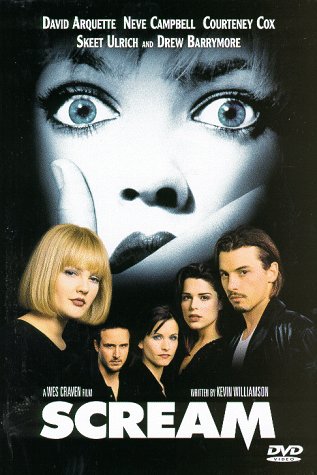
5. Scream (1996)
- What Is It? - Director Wes Craven's post-modern return to relevance. Coming back to a genre Craven gave nightmares years before, 1996's "Scream" was a snarky look at the vapidity of slasher movies. A riffing of tropes that had grown stale since the 80's and looked positively archaic by the more cynical mid-90's. "Scream" hit at just the right time, at once an effective and bloody horror movie in its own right and an oft-hilarious look at the traits that made slasher movies an ultra-formulaic, low budget moneymaker for so long. And one made by one of the masters of the genre, at that. In fact, one could argue that Craven's "Nightmare On Elm Street" was the original slasher movie game changer. A movie that took the killer out of the physical realm and turned him into a fear mongering ethereal specter. Bringing the supernatural back to the slasher genre and putting it in the forefront. Craven indeed always had his finger on a creative pulse of something new and ahead of its time. Something different.
But, one could argue that "Scream" was even more of a game changer. Where "Nightmare On Elm Street" become an institution, with annualized sequels and Freddy Krueger's growing mainstream popularity, its popularity at the time dragged it into the mire of the 80's. Its legacy was tarnished over time with too many sequels. Even with three sequels to its credit, "Scream" manages to maintain its overtly- cynical dignity. As cutting edge as it was at the time, "Nightmare On Elm Street" feels dated now. "Scream", despite being a product of its time, has held up to scrutiny. Coming just before the dawn of completely prevalent cellphone communication and wireless internet, "Scream" still hits that raw nerve of having just enough isolation to feel scary. "Scream" is a great reminder that, just because you can recognize something for what it is and laugh at it, that doesn't always make it less scary.
What Did It Influence? - Although its hard to put a proper tag on it, to many "Scream" represents the "modern horror movie". The snarky, clever, subversive, and self-aware movies that populated theaters in its wake. The "Urban Legends", "Valentines", "I Know What You Did Last Summer-s", of the world. The "smart" horror movies of the cynical 90's. What some would call "teenage horror". Whereas Freddy, Jason, Michael and the rest were antiquated dinosaurs. "Scream's" progeny were cutting edge. They were clever, quick-witted, inclusive, big budgeted slices of mainstream horror, even managing to hook a-list actors in the process. In short, "Scream" made horror movies "cool" again. At the expense, however, of a little bit of their soul.
Is The Influence Good - In all honesty, its hard to say. "Scream" brought horror back from the dead in the 90's. And, in doing that, gave the musty dinosaurs of the genre an impetus to reinvent themselves. "Bride Of Chucky" reinvigorated the dire doll series in 1999, "Jason X", which shot Jason into space, had its first draft and hype begin in the mid-90's. Notably, "Scream's" success even allowed Wes Craven to reboot his own dinosaur, dragging Freddy Krueger out of the tar pits in "Wes Craven's New Nightmare". In doing so, "Scream" may have relit the interest in these failing series. Certainly, audiences had to suffer through some mainstream pap to get there, but, it all ended fairly well for old-school horror fans. And that's pretty damn okay, from where I'm sitting.
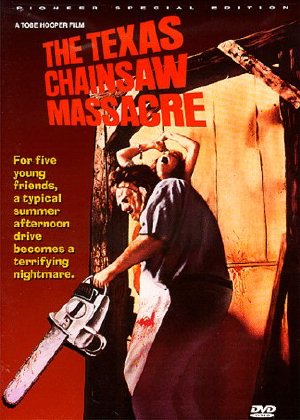
4. The Texas Chainsaw Massacre (1974)
-What Is It? - The seminal classic dirty horror movie. A drug-fueled, mafia funded, hippie horror opus. An indie middle finger to "the man" by horror visionary Tobe Hooper. "The Texas Chainsaw Massacre" is a dirty, nasty, spiteful tale of four friends traveling through Texas to investigate the graves of their family members, after a rash of vandalism spreads across the Texas countryside. Driving headlong into the Hellish Texas landscape, they find themselves isolated from civilization. Eventually, after an encounter with a nightmarish hitchhiker, the group finds themselves beset upon by a family of insane cannibal killers. They're killed off, one-by-one, until only the lovely Sally Hardesky remains. She's our final girl, the heroine in a nightmare.
"Chainsaw" finds itself, in the last third, helping to be the earliest example of what would come to be known as "torture porn". Despite being incredibly bloodless, the infamous "dinner scene" is torture nonetheless. Sally is not only physically abused, but also verbally and mentally, as well.
Of course, there's also the peak moment of physical torture, as one of the teens is hung on a hook in Leatherface's quarters. Leatherface seems to delight in the atrocity, as a child delights in a happy Christmas surprise.
What Did It Influence?- As mentioned before, "Chainsaw", one could argue, was one of the earliest movies responsible for creating the "torture porn" genre. The entirety of the film sees its characters tortured. From the outset, the Texas landscape (in reality shot during a summer where temperatures would routinely rise above 170 degrees in the shade.) suffocates the film and its characters in a blisteringly unpleasant atmosphere. The flat, obvious low budget feel, almost lending itself to a documentary style suggests a realism that permeates the entire film. Most of the deaths are matter-of-fact and to the point. The one's that linger, such as the aforementioned meathook scene, are torturous in their execution. They focus on details and the agony that sucks the viewers in while being repulsive at the same time.
Indeed so, the tenets of most modern "torture porn" movies try to emulate what "Chainsaw" pulled off. "SAW", "Hostel", and their brethren are gore movies through and through. They're what people at the time thought "The Texas Chainsaw Massacre" was. Many modern torture porn movies can nearly double as anatomy films. They're ultra-realistic and try to be horrifying down to the bone... in some cases, literally.
Is The Influence Good? - Honestly, I don't think so. If slasher movies permeated the horror movie landscape in the 80's then torture porn movies are the blight of modern horror cinema. They're brainless, often ultra predictable trash. In the horror market today, torture porn movies are churned out by hacks with too much emphasis on blood and gore effects and not enough character or soul. "SAW" and its multiple sequels made torture porn movies a quick trip to the effects workshop and an even quicker trip to the bank. Not good.
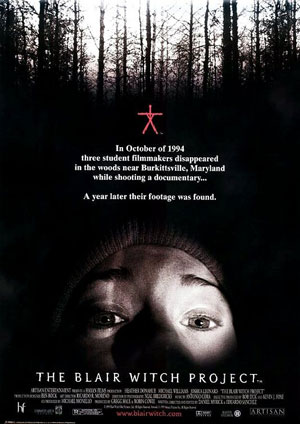
3. The Blair Witch Project (1999)
What Is It? - The ultra low budget tale of three amateur filmmakers documenting the local legend of the "Blair Witch". At once a character study, "evil in the woods" movie, and a virtually unscripted improvisational piece of post-modern horror, "The Blair Witch Project" accidentally created a genre of its own. Although not named for years, the handicam style (only used because the director and writer couldn't afford a pro rig on their miniscule budget) has become known as the "found footage movie".
Certainly, movies like the legendary video nasty "Cannibal Holocaust" could be classified as "found footage" in retrospect, but "The Blair Witch Project" was the first of this (nearly - only short by a year) Millennial genre to solidify the tenets of what makes a "found footage" movie. Isolation, fear, an impending sense of growing tension. The thrust of the story is simple, three characters (Heather, Josh, and Michael) hit the woods of Burkittsville, Maryland to investigate a local legend, the titular "Blair Witch" in 1994. Upon arriving, they treat their adventure like a light excursion, only budgeting for a couple days in the woods. The entire adventure is shot through the lens of a camera. Heather, essentially the de facto camerawoman, is our eyes and ears for the duration. Its not long before the trio become lost, harassed by unknown forces (the stick dolls and teeth are two methods - although, they're never assaulted by anything on camera), and, due to a case of exhaustion and anger, one of the trio deposits the map in a local river - stranding them even further into the woods.
What happens from there leaves the characters' fate unclear. They find themselves in the home of the local legend. During some excitement, the camera is dropped and left running. And that's the end. The film, in a meta sense of the word, is actually the cut and edited footage of the trio's last few days alive. The footage, in this sense, actually being recovered from the scene.
What Did It Influence? - Virtually countless "found footage" movies, for years to come. Being the lowest budgeted theatrical film of 1999, and one of the highest grossing independent films of all time - a record it held until the last few years - the rip-offs, copycats and wannabes were inevitable. Before the advent of the term "found footage", most of this first wave weren't very good and were simply tagged as "Blair Witch rip-offs". They were independently produced, slapdash, straight to home market faire, swapping witches out for ghosts and usually being cast aside as the cash-ins they were. However, the next generation of found footage movies would be the genre's renaissance, with a string of solid entries into the genre; "Paranormal Activity" kicked off the boom, movies like "Troll Hunter" took the found footage genre out of horror for a different spin. Even movies like the criminally overlooked "Home Movie" made for effective and creepy viewing. In all, "The Blair Witch Project" may have birthed a genre by accident, but its a genre that's here to stay.
Is The Influence Good? - It can be. Like every genre, the viewer needs to expect to take the good with the bad. The "found footage" boom in recent years has lead to a lot of bad. From mixed bags like "V/H/S" and its sequel to the growing bloat of the "Paranormal Activity" sequels (with a new one due out Spring 2014, its October release being preempted by Jackass's "Bad Grampa", of all things.), to uninspired trash like the spaced-out "Apollo 18" (Who did get that footage off the moon, anyway?) even down to veteran directors like George A. Romero failing to grasp the genre in his disappointing "Diary Of The Dead". That being said, the good can far outweigh the bad. Good "found footage" horror drags the viewer in, closes a world in around them and never cuts away. At their best, they can be creepy, engaging, and downright terrifying. And due to the low budget nature of their style and ability to be bent to any whim, "found footage" movies are unlikely to permanently stagnate. If you have patience for some bad or poorly executed stuff, there's definitely some good to find out there too.
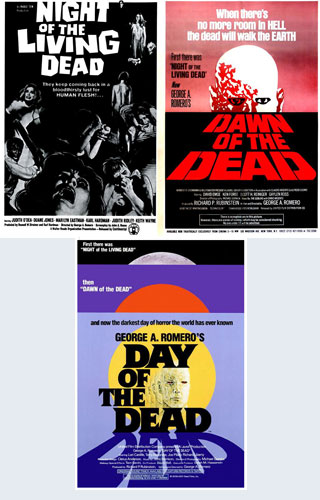
2. George A. Romero's "Dead Trilogy"
- "Night Of The Living Dead"(1968)/ "Dawn Of The Dead" (1978)/ "Day Of The Dead" (1985)
What Are They - Director George A. Romero's Holy Trilogy of flesh eating zombie violence, Reagen-era cynicism, and a "we are them and they are us" apocalypse of the human condition. Romero's "Dead Trilogy" represents the eras each film was created in, while bridging time, societal issues, and once timely riffs on pop-psychology social issues to codify, almost universally, what it means to be a "zombie movie".
Coming first, in the paranoia-fueled late 60's, "Night Of The Living Dead" sees people lock themselves in an abandoned farmhouse as encroaching hordes of the undead are attacking from all sides. Barricaded inside, they have no means of escape and their only line to the outside world seems to be a television set and a radio, each spewing rhetoric that could only help those listening; "The corpses of the recently deceased are returning to life. Stay inside and lock your doors."
Fear and paranoia rule the day, as the film openly allegorizes the 1960's fear of a Russian incursion onto American soil. The party lines are drawn, as each group of characters openly represents the different viewpoints exhibited by social parties of that era. One wants to run, one wants to stay put and go on the attack, one wants to barricade himself and his family into the basement - a move that others warn would be a bottleneck deathtrap if the creatures get inside - and no one can agree on anything.
Rarely does the film cut outside, as the zombies are going about their own business, slowly but surely amassing outside. As Americans feared the Russians were doing in Cuba, readying themselves for an assault.
As the film reaches its conclusion, in-fighting among the survivors allows the creatures to encroach on the house. Soon, Barbara, the only female survivor along with Ben (a black man) are all that are left. Another commentary on 1960's America. The persecuted populace of women and African Americans are the last people standing in a war. That is, until, a group of police officers and hunters shoot and kill Ben. Whether they killed him because they thought he was a zombie or because of his race is still debated to this day.
"Dawn Of The Dead" would come on the heels of "Night Of The Living Dead's" success. Opening in the midst of a virtual war between humanity and the wave of mutilation known as zombies, "Dawn Of The Dead" is a more heroic feature. More light and breezy, but still violent and bloody.
Casting aside his political satire, Romero instead aims at consumer culture, remember, in the 1970's shopping malls were still kind of a big deal. One character actually reacts in open mouthed awe at seeing one calling it "one of those giant indoor shopping centers".
As the apocalypse continues, and Hell walks the Earth around them, a group of survivors find themselves taking refuge in a shopping mall. There, they clear it out, seal themselves in, and wait for an "all clear" that's presumably never coming.
What makes "Dawn Of The Dead" different than its predecessor is the humor the environment injects into it. The characters seem to have an absolute blast living in a mall, ransacking stores, robbing the bank, and even taking the time to play in a vintage arcade (Remember those?).
And that's the thrust of the satire this time. These characters aren't oblivious to the carnage around them. Clearly. But, due to their favorable surroundings, they're at least blinded to it. They can ignore it.
They ignore it, at least, until a group of pillaging bikers, lead by special effects legend Tom Savini (who, funnily enough, would reprise this same role in Romero's "Land Of The Dead", and direct the 1990 remake of "Night Of The Living Dead") break in and bring chaos with them. Attacking the survivors in gun battles and even allowing hordes of gathered zombies in with them.
The last twenty minutes of "Dawn Of The Dead" is a masterwork of chaos; a three way battle between the asshole bikers, the survivors and the zombies.
In the end, our heroes escape. Once again, the combination of an African American and a woman, among others. A happy, if ambiguous ending.
"Day Of The Dead", the last of Romero's original "Dead Trilogy", is anything but happy. Its an angry, misanthropic, stripped down movie, that sees the world officially overrun by the zombie masses and the last few survivors driven to living in underground bunkers.
"Day Of The Dead" is a cynical masterpiece. A blackly comedic look at science versus the military machine and even delving into the topic of "nature vs. nurture" as a scientist (only ever referred to as "Doctor Frankenstein") tries to rehabilitate a captured zombie as military leader, Captain Rhoads decries his research as lunacy.
The thrust of the movie is again, like "Night Of The Living Dead" before it, black, sickening, suffocating paranoia. The gathered mishmash of survivors have no where else to go. They're trapped underground as the world topside is slowly torn apart. And even with that common problem, they can't get along. Their ideologies constantly at odds.
By the last act of the film, we get the usual zombie attack. The bunker is overrun and, for all we know, humanity's last remnants are backed into a corner with nowhere else to go. Survivors are ripped asunder as the zombie scourge shreds them to mere pieces. Even the supposed "happy ending" rings false. As survivors find themselves on an island. Remote and beautiful, the movie ends ambiguously. Who knows what horrors could lurk further inland?
What Did They Influence? - Well, without much exaggeration... every zombie movie ever. Despite bridging generations, changing tastes, changing political climates, and even changing standards in movie censorship, Romero's "Dead Trilogy" has solidified the zombie movie. Taking away the satire and social commentary, Romero's movies gave us likeable characters and implacable and numerous enemies to root against. The survival of the human race is a rooting interest and that's something we can all get behind. Not to mention, the mere concept of zombies as a movie villain. And everything a about them. Romero created "rules" that are still followed to this day. And, not following them is tantamount to movie treason. Remember the controversy that abound when the much-maligned "Dawn Of The Dead" remake announced it would use the much hated "fast zombie"? Or the outcry when the recent "World War Z" adaptation broke, not only the novel's rules, but Romero's? Certainly some zombies are different. Some have their own spin to them. But, the strain of zombie disease can always be traced back to Romero's "Dead Trilogy".
Is The Influence Good? - Yes. Before "The Dead Trilogy" zombies were an oft-forgotten voodoo legend, rarely given any movies of prominence. When Romero, maverick he was, decided to create his own zombie - a shambling corpse given life through unknown means, spreading its condition to others via bites, eating human flesh, and only being vulnerable to the destruction of its desiccated brain - Romero firmly influenced a genre to the point where he's credited as creating it. Without the "Dead Trilogy" and Romero's deft directorial hand, we wouldn't have things as far reaching as "The Walking Dead" TV series, the "Resident Evil" video games, or the countless films it inspired. Not bad for a low budget film created by some goof from Philly, huh?
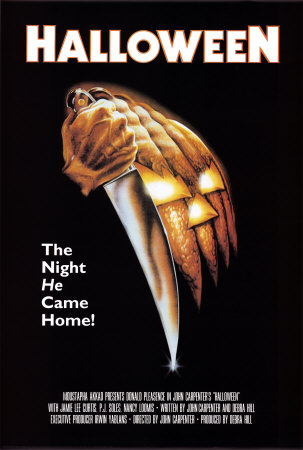
1. Halloween (1978)
What Is It? - The shining star of a dirty genre. The progenitor of endless series and endless millions of dollars in profit. A shock rocker's jumping off point for creating a cult trash treasure . Its purely and simply evil. And purely and simply, "Halloween" - the night he came home.
John Carpenter's "Halloween" is a diamond among coal in the film world. A shining example of what one director, with enough skill, talent, and ingenuity, can do even with a miniscule budget and the logistical nightmare of having to shoot late-summer California for late-autumn suburban Illinois.
To put it quite simply, "Halloween" is a very simple movie. It follows Jamie Lee Curtis as Laurie Strode, on Halloween, doing what many normal teenagers do; partying, smoking a little weed, and hanging out with her annoying friends. Laurie's the kind of plain, goody two shoes girl that could only exist in a movie. But, because of the deft writing skills behind the film, Laurie never comes across as overly prudish. She's just a little smarter, more responsible, and more thoughtful than her traditionally bullheaded horny friends.
However, to the film's credit, none of the supporting cast are ever overly annoying. You don't want to see these people die. Sure, some of them are dumb, annoying, or bitchy. Certainly, they make stupid decisions or do stupid things (I'm still trying to figure out how that one chick locked herself in the detached laundry room.), but they all seem like genuinely good people. You can see how, unlike many movies of "Halloween's" ilk, these people can actually be friends.
The thrust of the story, based on that, is very simple too. Laurie and her various friends are staying indoors on Halloween night. Laurie's babysitting, her friends are looking to drink beer and score. Then "He" shows up. Having escaped from the mental institution and being pursued by the incomparable Dr. Sam Loomis, played by respected actor Donald Pleasance, in what would unfortunately, be the great actors waning days, Michael Myers is a force to be reckoned with. Though he walks like a man, Loomis fears him as a child fears the Boogeyman. As a child, Michael killed his sister on Halloween night. Now, on Halloween, he returns again to take his pound of flesh from the residents of the peaceful small town.
He stalks Laurie and her friends by day. By night, Michael makes his move as Loomis is in pursuit, often mere steps behind. At one point, Loomis is staring ahead at the camera, deep in thought. Behind him, Michael drives passed him in the stolen institution car - literally mere feet away.
Eventually, the film ends its predictable trajectory. Michael, Laurie, and Loomis are all that remain of the key players. Michael attacks Laurie, Loomis intervenes just in time, shoots him six times, and Michael tumbles over the balcony to his apparent death.
"Halloween" was, in its time, lauded as a successful horror picture. Well respected by critics, it launched John Carpenter into stardom. It grossed well over its small budget, making it, for its time, the most successful independent film of the era. Perhaps most importantly were the far reaching influences of "Halloween". In creating one of the last old-fashioned horror shows of the 70's, Carpenter created a genre that would sustain an industry for years to come. What Did It Influence? - The slasher movie. Plain and simply, it legitimized a genre, gave it its template, and proved money could be made with a mostly amateur cast, a killer in a mask, a little T and A, and some people being murdered until there's one "final girl" left. "Halloween" proved the adage of "if you build it, they will come." It influenced a genre that would be diluted with every new film or franchise thrown into the pot, from "Friday The 13th" to "Nightmare On Elm Street", to "Child's Ply" all the way, recursively, down to its own increasingly awful sequels and remakes. "Halloween", in a few weeks and without really trying, created a legacy.
Is The Influence Good? - Unequivocally, yes. Sure, there's a lot of bad slasher movies. Movies that feel like they were scripted with a checklist in hand. "1. Boobs? Check. 2. Stereotypical characters based on types rather than actual rational people? Yep. 3. Characters who do drugs, drink, or have sex die? Done. 4. Final girl is a prudish virgin? Got it. 5. All the characters die in bloody, creative ways? Done and done. Let's get lunch. I need my two 'o clock high ball."
That being said, there's plenty of good stuff out there. And the bad or forgettable stuff, especially by this point, has been buried by time.
Let's not forget as well, "Halloween's" success, leading to "Friday The 13th" and "Nightmare On Elm Street", helped studios stay open. The low budget, high yield results of "Friday The 13th" kept Paramount Studio's lights on, when their financials were waning after a series of flops. Similarly, "Nightmare On Elm Street" dug New Line Cinema out of the red, to the point where, at one time, an executive nicknamed New Line Cinema "The House That Freddy Built".
None of this would have been possible, or at least made possible nearly as quickly, if it hadn't been for the arrival and subsequent mega success of John Carpenter's little horror show. Some of "Halloween's" offspring came out wrong, some of its soul stripped away by quick cash-ins, rip offs, and directors and distributors trying to make an easy buck - but the legacy and influence of "Halloween" can't be denied. It kept studios open, families fed, and inspired film series that are still going today. And from where I'm sitting, that's a good influence to have.
Comment about this article on Da' Wrestling Boards!
back to Flashback Index